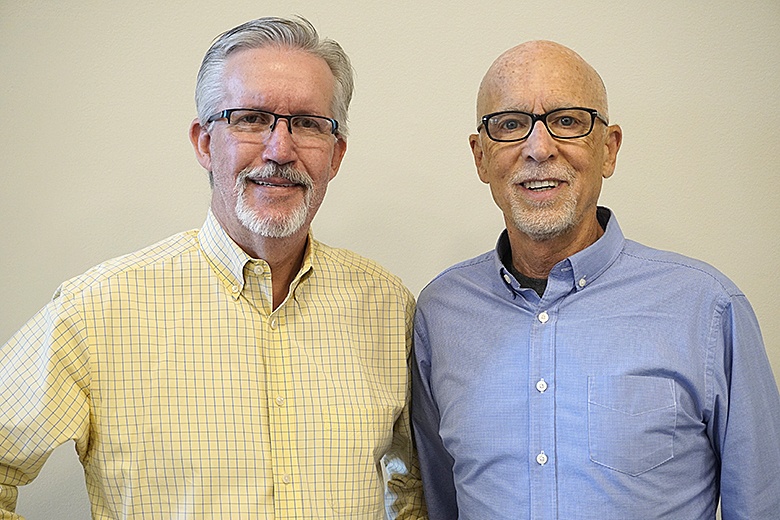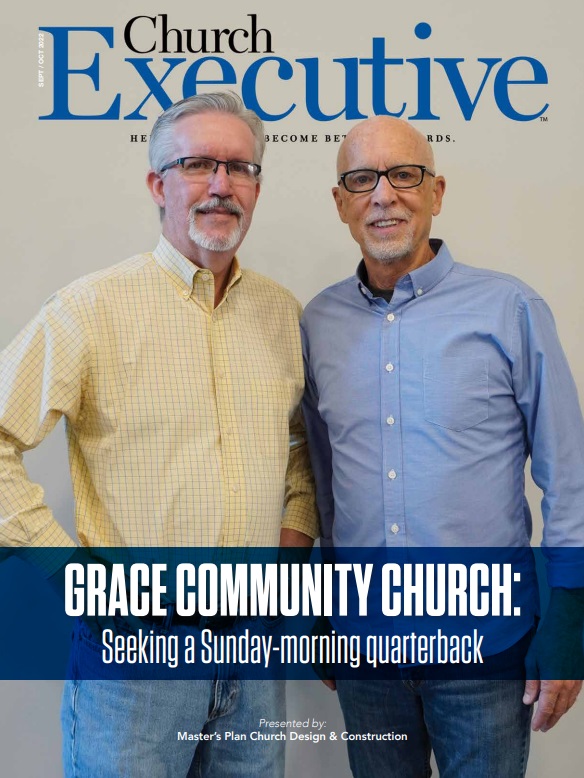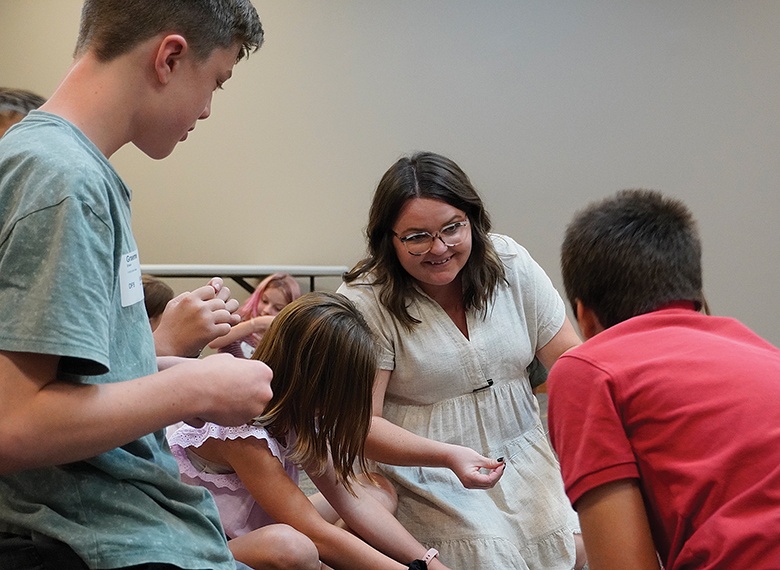
By RaeAnn Slaybaugh
No pastor can — or should — undergo a major building project without the right bench strength
Rod MacIlvaine is no stranger to ‘quarterbacking’ a church building project.
What he didn’t want to do with the new, 16,000-square-foot facility at Grace Community Church in Bartlesville, Okla., however, was navigate a third such project in this fashion.
That’s where the right building partner came in.
Rod MacIlvaine initially came to Grace Community Church in Bartlesville, Okla., after being invited to a small group Bible study. Although he was born in New York — and by that time had planted a church in Los Angeles — MacIlvaine was at the time feeling called back to the Midwest, where he was raised.
“I began to realize that [this suburb of Tulsa] was a community that would be ideal for our kids; my family was my No. 1 priority,” he recalls. “I knew that if I was going to plant a church again, I’d want to do it in a community like this one.”
And so he did.
MacIlavine met with the Bible study group on a church planting consultant basis, initially. In November 1994, he led a retreat for the group. Within seven months, he came on as the founding senior pastor of Grace Community Church.

Not his first Super Bowl
When the time came to expand the church facilities in 2020 — something leaders began considering in 2019 — Grace Community Church was in good hands.

Just as GCC wasn’t MacIlavine’s first foray into church planting, it wasn’t his first building project either.
“I realized the true cost of church planting,” he says. “We had gone through two previous building projects, and I was way more involved in those than I felt like my gifts justified.”
This time, what MacIlvaine was looking for was a quarterback — someone to carry the project from start to finish, letting him focus on ministry. He found it by way of introduction when a fundraising consultant he worked closely with said he should meet Rodney James, president and founder of Master’s Plan Church Design & Construction.
MacIlvaine and his team invited James to an elder meeting and peppered him with questions. What sealed the deal was confidence that the process would be handled, from beginning to end, by James and his team.
“Again, that’s very much what I wanted,” MacIlvaine reiterates. “I didn’t mind being involved, but I needed people who had broader expertise.”

Calling the plays
James went above and beyond, putting MacIlvaine in touch with a stewardship consultant. He worked with the architects and the city. He even offered a guaranteed price.
But these weren’t the biggest elements of success; above all, the church’s objectives for the project needed to be understood and translated into a plan.
To this end, James embraced the fact that leaders at Grace Community Church were looking for a long-term ministry solution, not just another building. In particular, they first wanted to focus on providing adequate, safe and expanded space for children and students.

As MacIlavine recalls, the kids’ and students’ spaces weren’t up to par. The addition built in 2002 didn’t meet a lot of standards set by other churches across the country.
“People noticed this,” he points out. “Let’s say they’d moved here from Dallas or from Kansas City; they would note the fact that our ministry areas weren’t built with the kind of safety measures they were used to in their prior churches.”
The goal, then, became to bring children’s and student ministry spaces up to a level where parents could feel confident that their kids would be safe there.
“We were focused on a higher level of ‘on-the-ground’ security measures for our kids,” explains Associate Pastor Dale Willis, the church’s daily point person on the project. “In the original space, hallways were shared by everyone who entered the building. The new space allows for a segregated environment for all kids and youth.”
The church also gained a lot of space for these mission-critical ministries: about 16,000 square feet. Roughly speaking, 45 percent is dedicated to serving middle school and high school students. Children’s ministry spaces occupy another 45 percent. The remaining 10 percent is dedicated to 5th and 6th graders.
“Our ministry brand is summed up in the word ‘transformation,’” MacIlvaine explains. “We talk about it all the time — the fact that transformation is often quirky, awkward, zigzagging; it’s not straight line. There are always trials and difficulties. And then, sometimes, fantastic things that happen.”

In the context of ministering to children and students, this meant creating a place where the church could do work that would actively transform the next generation.
“So many parents are just going crazy, because they feel like they’re losing their kids to screens; they’re losing their kids to peers; they’re losing their kids to unfortunate school situations,” he points out. “Our goal, really, is to profoundly impact the next generation.”
And not just when they’re young, he adds — GCC aims to help parents ground their kids in a steady, enduring faith. “Not a faith that’s trendy, that [youth] will abandon when they go to college,” he explains. “We want to instill a faith that will bring them through some challenging times.”
Of course, determining what that looks like, in bricks and mortar, requires a different kind of expertise than MacIlvaine himself possesses. Again, enter the Master’s Plan team. MacIlavine credits James and his team as being “really good at taking what we wanted and putting it on paper, in terms of an architectural plan.”
A focus on zone coverage
Crucially, the new space achieves a second objective for GCC: to expand the church’s Celebrate Recovery ministry. This popular, mission-critical offering has been an active part of the church for nearly two decades.
Over the years, Celebrate Recovery events have been instrumental in welcoming new people to the church. “A lot of people who don’t go to our church, will come to Celebrate Recovery,” MacIlvaine says. “Sometimes they’re mandated by a judge to attend; other times, a spouse has said, ‘Get help or I’m out of here’; and sometimes a doctor or psychologist recommends [the program],” he adds. “Whatever their reasons are for coming, this is a way for us to reach into the community without leaving the walls of our building.”
Prior to COVID, MacIlvaine and his team were serving a delicious meal at the church every Monday night for its Celebrate Recovery events. When the pandemic hit, these gatherings had to be shut down. They were rebooted, post-pandemic, but attendance waned.
To ramp back up to previous levels of attendance (and beyond), the GCC team knew it needed to expand its kitchen facilities to a setup that would let them serve a large meal for more than 100 people every Monday night. With their new space, the kitchen doubled in size, allowing for a dedicated pantry space (instead of a small closet), and for larger refrigerator and freezer to accommodate all the ministries which use the kitchen.
Now, the church hosts two services on Sundays, at 9:30 a.m. and 11 a.m. The Monday night Celebrate Recovery event functions, unofficially, as a third service. On this one evening, a meal is served between 5:30 p.m. and 6:15 p.m., followed by a large group gathering that includes worship and a short teaching or testimony. Small groups, or “open share groups,” meet after that. Then, dessert is served.
“It becomes an entire evening,” MacIlvaine points out. “Crucially, part of what this new building plan included was space so that that this ministry could flourish.”
The space is also designed to accommodate expanded worship space in the future, if this becomes something GCC leaders want to do.
A true touchdown
Real quarterbacking involves more than just creating a space that works. As MacIlavine points out, it also means coming alongside the church in the areas of capital fundraising and even lending options.
Regarding the former, James introduced MacIlvaine and his team to Chuck Klein, president and principal owner of Impact Stewardship Resources, Inc.
“Rodney and Chuck have a great relationship,” he says. “We had some bumps in the road during COVID — I think probably everybody did — but that nevertheless ended up being a fruitful relationship for us.”
Moreover, James proved instrumental in helping church leaders frame their financing needs in a way that maximized financial stewardship. He also helped them select the right local lender and loan package.
“In other words, we didn’t have to make an outlay of money that was more than what we should have or could have done,” MacIlvaine explains. “So, that was very, very helpful.”
QUICK FACTS ABOUT
GRACE COMMUNITY CHURCH:
Year established: 1995
Number of staff — full- and part-time: 10 / 5
Combined weekly attendance: 750
Instant replay!
Having now sat at the helm of three significant church building projects, MacIlvaine says he has three main pieces of advice for other pastors in the same boat:
#1: Have at least $250,000 in the bank before starting a project. Expenses come up prior to fundraising and before securing a contractor — consulting, for example, MacIlvaine cautions. “It’s important to have a cushion of money in the bank prior to that process.”

#2: Spend a lot of time with staff determining them what they need from the project. “Press them about the what-ifs — What would you do if this happened?” he advises.
For GCC’s part, this extended beyond staff to parents. “We feel like we got some really good input from the congregation,” he says. “I know pastors always want to do that, but sometimes it can get bogged down. So, we made sure the parents and the staff all had their say.”
#3: Get yourself a quarterback. As MacIlvaine says: “It made all the difference in the world for me, as the senior pastor, to know that Rodney and his team were going to quarterback the whole thing.”
Practically, this meant that Master Plan’s John Branson was on hand every day as a site supervisor. He communicated what was going on with the church’s point person on the project, Associate Pastor Dale Willis, daily.
MacIlvaine says he particularly appreciated that Branson is a follower of Christ. “John is very relational,” he says. “And when our building was open to the snowy weather, he was there — on a Saturday — ensuring that there was no snow going into our building. When a bunch of rain came through during construction phase, he made sure the building was protected. The whole thing was fantastic.”
The net effect was a level of comfort and confidence in the project that GCC leaders could count on.
“In his book, Leadership Jazz, Max DePree talks about the importance of ‘lavish communication,’” MacIlvaine concludes. “I feel like we had that — lavish communication.
“In a construction project, that’s what you need.”


